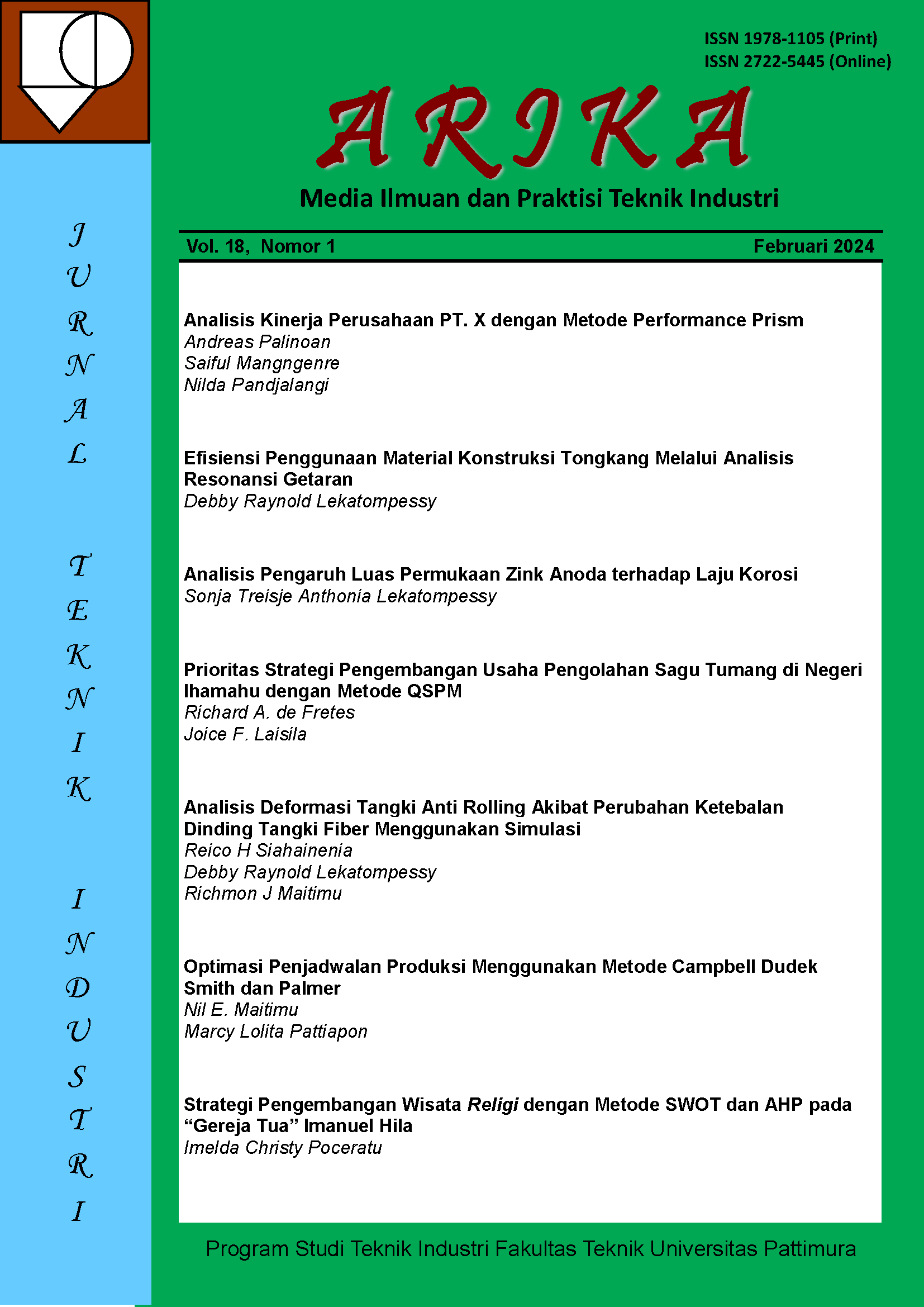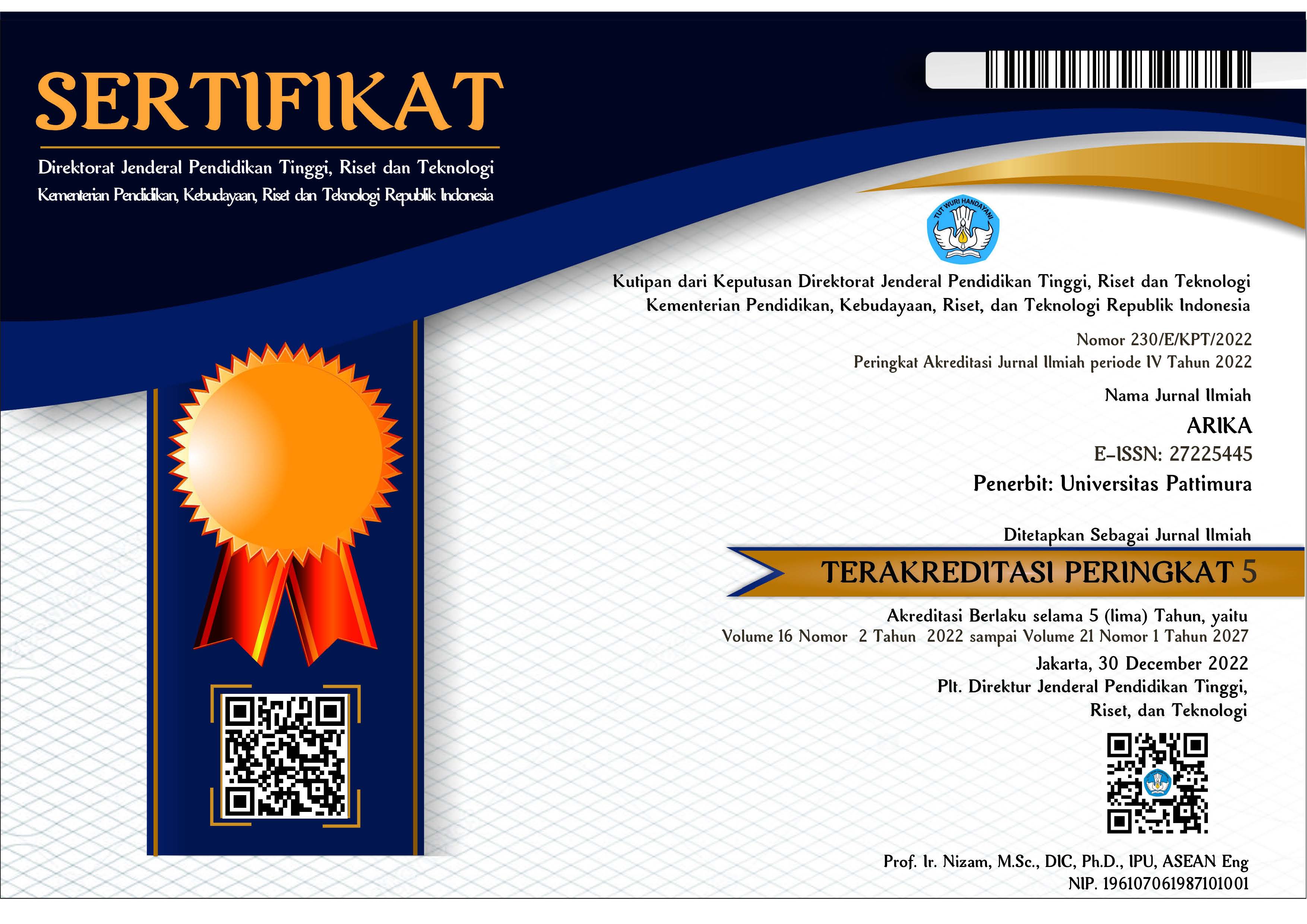Efisiensi Penggunaan Material Konstruksi Tongkang Melalui Analisis Resonansi Getaran
Abstract
Objek penelitian ini adalah tongkang yang beroperasi di Kalimantan, dengan material muatan adalah batubara. Kekuatan struktur dan besarnya beban merupakan dua faktor penting dalam desain dan pengoperasiannya. Semakin kuat suatu struktur maka semakin aman dari segi persyaratan teknik, namun akan mengurangi beban yang berarti akan menurunkan nilai ekonomisnya. Agar efisiensi kedua faktor diatas dapat tercapai, maka perlu dilakukan rekayasa konstruksi tongkang melalui analisis resonansi getaran. Metode yang digunakan dalam penelitian ini adalah gabungan antara penelitian survei dan pengembangan. Metode pengembangannya dilakukan dengan rekayasa pada void tank dengan menggunakan analisis resonansi getaran untuk menentukan titik kritis dan analisis kekuatan struktur pada area tersebut berdasarkan nilai kekakuan yang dihasilkan. Rekayasa dilakukan dengan penyesuaian jarak dan dimensi tiang penyangga pada void tank, serta tulangan penguat diagonalnya. Jumlah tulangan penguat diagonal berkurang 50% atau bobot berkurang 12,69 ton. Pilar bertambah berat 6,241 ton. Hasil dari rekayasa struktur ini menghasilkan peningkatan kekuatan struktur sebesar 27%, pengurangan lendutan sebesar 45,2% dan beban dapat ditingkatkan hingga 0,42% atau 6,45 ton dari beban awal yang dapat dipikul. Luaran dari penelitian ini adalah desain tongkang yang lebih ringan (biaya produksi lebih murah) sehingga daya dukungnya meningkat yang berarti menguntungkan pemilik kapal namun tetap aman dalam pengoperasiannya.
Downloads
References
Chen, H. (2023). Simulation research on ship electric propulsion speed regulation system based on variable structure control and FPGA. Optik, 272, 170265. https://doi.org/10.1016/j.ijleo.2022.170265
Grice, R. M., & Pinnington, R. J. (2000). A METHOD FOR THE VIBRATION ANALYSIS OF BUILT-UP STRUCTURES, PART I: INTRODUCTION AND ANALYTICAL ANALYSIS OF THE PLATE-STIFFENED BEAM. Journal of Sound and Vibration, 230(4), 825–849. https://doi.org/10.1006/jsvi.1999.2657
Hirdaris, S. E., Bai, W., Dessi, D., Ergin, A., Gu, X., Hermundstad, O. A., Huijsmans, R., Iijima, K., Nielsen, U. D., Parunov, J., Fonseca, N., Papanikolaou, A., Argyriadis, K., & Incecik, A. (2014). Loads for use in the design of ships and offshore structures. Ocean Engineering, 78, 131–174. https://doi.org/10.1016/j.oceaneng.2013.09.012
Imron, A. (2014). Kerusakan struktur akibat getaran lokal pada kapal yang jarang diperhatikan; Analisis dan solusi (Studi kasus). Jurnal Kelautan Nasional, 9(1), 11–19. https://doi.org/10.15578/jkn.v9i1.6198
Kanwal, G., Ahmed, N., & Nawaz, R. (2024). A comparative analysis of the vibrational behavior of various beam models with different foundation designs. Heliyon, 10(5), e26491. https://doi.org/10.1016/j.heliyon.2024.e26491
Kim, I.-T., Kim, S., Paik, K.-J., Yang, J.-K., & Kwon, S.-Y. (2023). Free-running CFD simulations to assess a ship-manoeuvring control method with motion forecast in waves. Ocean Engineering, 271, 113806. https://doi.org/10.1016/j.oceaneng.2023.113806
Lekatompessy, D. R. (2021). The effect analysis of the stiffness changes of a Traditional Fishing Boat Foundation on Vibration Amplitude. TEKNIK, 42(1), 71–78. https://doi.org/10.14710/TEKNIK.V42I1.30978
Lekatompessy, D. R. (2023). Local vibration reduction of machine support systems through transmissibility pattern analysis in resonant construction. AIP Conference Proceedings, 2588(1), 040012. https://doi.org/10.1063/5.0111908
Lekatompessy, D. R., Ariana, I. M., Zubaydi, A., & Erwandi, E. (2017). The Vibration Characteristics of Gofasa Wood (vitex cofassus). International Review of Mechanical Engineering (IREME), 11(9), 644–650. https://doi.org/10.15866/IREME.V11I9.11636
Li, L., Bruset, M., Ong, M. C., & Wu, X. (2020). Numerical Analysis of a Floating Fish Cage With Feeding Systems. Volume 5: Ocean Space Utilization, V005T05A001. https://doi.org/10.1115/OMAE2020-18112
Lin, T. R., Pan, J., O’Shea, P. J., & Mechefske, C. K. (2009). A study of vibration and vibration control of ship structures. Marine Structures, 22(4), 730–743. https://doi.org/10.1016/J.MARSTRUC.2009.06.004
Lin, Y.-H., Chih Lin, Y., & Tan, H.-S. (2019). Design and functions of floating architecture – a review. Marine Georesources & Geotechnology, 37(7), 880–889. https://doi.org/10.1080/1064119X.2018.1503761
Mauro, F., Vassalos, D., Paterson, D., & Boulougouris, E. (2023). Evolution of ship damage stability assessment—Transitioning designers to direct numerical simulations. Ocean Engineering, 268, 113387. https://doi.org/10.1016/j.oceaneng.2022.113387
Rodrigues, L. A. S., Loayza L, C. R., Borges, D. J. A., Baia, P. E. C., Freitas, E. N., & Braga, E. M. (2019). Welding procedures influence analysis on the residual stress distribution and distortion of stiffened panels welded via robotized FCAW. Thin-Walled Structures, 141, 175–183. https://doi.org/10.1016/j.tws.2019.03.055
Wang, G., Martin, T., Huang, L., & Bihs, H. (2022). Numerical investigation of the hydrodynamics of a submersible steel-frame offshore fish farm in regular waves using CFD. Ocean Engineering, 256, 111528. https://doi.org/10.1016/j.oceaneng.2022.111528
Copyright (c) 2024 Debby Raynold Lekatompessy

This work is licensed under a Creative Commons Attribution-ShareAlike 4.0 International License.
An author who publishes in the ARIKA Jurnal agrees to the following terms:
- The author retains the copyright and grants ARIKA journal the right of first publication of the work simultaneously licensed under the Creative Commons Attribution-ShareAlike 4.0 License that allows others to share the work with an acknowledgment of the work's authorship and initial publication in this journal.
- The author is able to enter into separate, additional contractual arrangements for the non-exclusive distribution of the journal's published version of the work (e.g., post it to an institutional repository or publish it in a book) with the acknowledgment of its initial publication in this journal.
- The author is permitted and encouraged to post his/her work online (e.g., in institutional repositories or on their website) prior to and during the submission process, as it can lead to productive exchanges, as well as earlier and greater citation of the published work (See The Effect of Open Access).










